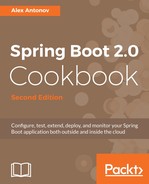- First, we will remove the programmatic database population which we created in Chapter 2, Configuring Web Applications. So let's comment out the following code from the StartupRunner's run(...) method:
Author author = new Author("Alex", "Antonov");
author = authorRepository.save(author);
Publisher publisher = new Publisher("Packt");
publisher = publisherRepository.save(publisher);
Book book = new Book("978-1-78528-415-1", "Spring Boot Recipes", author, publisher);
bookRepository.save(book);
- If we were to run our tests, they might fail if the test.h2.db file is missing because they expect the data to be in the database. We will populate the database by creating a Hibernate import.sql file in the src/main/resources directory at the root of our project with the following content:
INSERT INTO author (id, first_name, last_name) VALUES (1, 'Alex', 'Antonov')
INSERT INTO publisher (id, name) VALUES (1, 'Packt')
INSERT INTO book (isbn, title, author_id, publisher_id) VALUES ('978-1-78528-415-1', 'Spring Boot Recipes', 1, 1)
- On running the tests again by running ./gradlew clean test, they are magically started and get passed again.
- Another way to do this is to use the Spring JDBC support for schema.sql and data.sql. Let's rename the newly-created import.sql file to data.sql and create a schema.sql file in the same directory with the following content:
-- Create syntax for TABLE 'author'
DROP TABLE IF EXISTS `author`;
CREATE TABLE `author` (
`id` bigint(20) NOT NULL AUTO_INCREMENT,
`first_name` varchar(255) DEFAULT NULL,
`last_name` varchar(255) DEFAULT NULL,
PRIMARY KEY (`id`)
);
-- Create syntax for TABLE 'publisher'
DROP TABLE IF EXISTS `publisher`;
CREATE TABLE `publisher` (
`id` bigint(20) NOT NULL AUTO_INCREMENT,
`name` varchar(255) DEFAULT NULL,
PRIMARY KEY (`id`)
);
-- Create syntax for TABLE 'reviewer'
DROP TABLE IF EXISTS `reviewer`;
CREATE TABLE `reviewer` (
`id` bigint(20) NOT NULL AUTO_INCREMENT,
`first_name` varchar(255) DEFAULT NULL,
`last_name` varchar(255) DEFAULT NULL,
PRIMARY KEY (`id`)
);
-- Create syntax for TABLE 'book'
DROP TABLE IF EXISTS `book`;
CREATE TABLE `book` (
`id` bigint(20) NOT NULL AUTO_INCREMENT,
`description` varchar(255) DEFAULT NULL,
`isbn` varchar(255) DEFAULT NULL,
`title` varchar(255) DEFAULT NULL,
`author_id` bigint(20) DEFAULT NULL,
`publisher_id` bigint(20) DEFAULT NULL,
PRIMARY KEY (`id`),
CONSTRAINT `FK_publisher` FOREIGN KEY (`publisher_id`) REFERENCES `publisher` (`id`),
CONSTRAINT `FK_author` FOREIGN KEY (`author_id`) REFERENCES `author` (`id`)
);
-- Create syntax for TABLE 'book_reviewers'
DROP TABLE IF EXISTS `book_reviewers`;
CREATE TABLE `book_reviewers` (
`book_id` bigint(20) NOT NULL,
`reviewers_id` bigint(20) NOT NULL,
CONSTRAINT `FK_book` FOREIGN KEY (`book_id`) REFERENCES `book` (`id`),
CONSTRAINT `FK_reviewer` FOREIGN KEY (`reviewers_id`) REFERENCES `reviewer` (`id`)
);
- As we are now manually creating the database schema, we will need to tell the Hibernate mapper not to automatically derive one from the entities and populate the database with it. So, let's set the spring.jpa.hibernate.ddl-auto=none property in the application.properties file in the src/main/resources directory at the root of our project.
- Execute the tests by running ./gradlew clean test and they should get passed.
